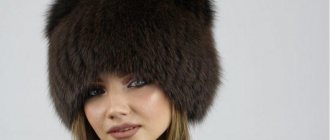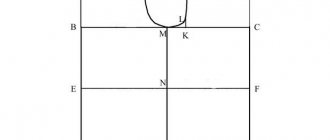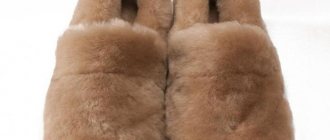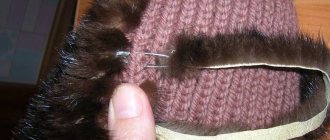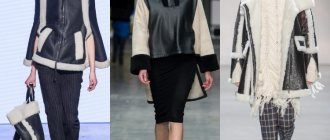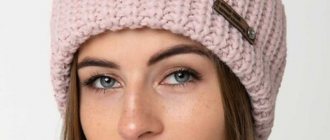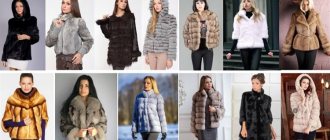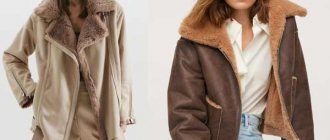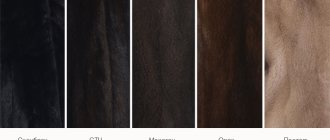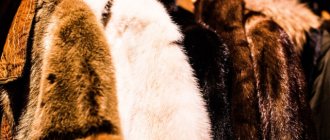Russian winter is famous for its severe frosts and cold winds. Therefore, starting in the fall, it is necessary to stock up on warm clothes so that the cold causes us a minimum of discomfort.
It is very important to keep your hands warm in winter; the influence of the weather can cause great harm, because this is when our hands dry out and crack, they require careful care and, of course, protection on cold days. There are a great variety of gloves and mittens on sale for this purpose. But it’s not always possible to find what you like. In this regard, the option of sewing fur mittens at home is relevant.
Why them? Fur mittens have become fashionable recently. Such an original piece of clothing made from rabbit, mink and other types of fur will ideally complete a winter look, especially if the fur matches the color of a fur coat or jacket. Meanwhile, it is very difficult to buy mink fur mittens, because their price is high. But we suggest you save a considerable amount, while adding a very unique item to your wardrobe by sewing mittens with your own hands.
Such mittens will not only protect the hands of their owner from the harsh influence of frost, but will also warm the soul, because they will be made with love.
What will you need for this? Everyone has old, unnecessary fur coats or hats at home that no one wears, but it’s a shame to throw them away. They will go to work.
A great excuse for crafting
Many girls are fond of handicrafts and design fashion accessories for themselves, using imagination and creative thinking. And if a fashionista cannot yet classify herself as a needlewoman, then mink fur mittens are a great start for mastering the creative path. In addition, at home, grandmother’s collars or an old hat, hopelessly out of fashion, are probably gathering dust in the closet. If you visit a fur atelier, you can probably stock up on leftovers from sewing products or fur tails. To the delight of the craftswomen, there is now no shortage of materials.
Purpose of workwear
The direct purpose of workwear is to protect people from injury when performing various types of work. Mittens perform several functions:
- protection of hands from cold;
- from causing various types of injuries - cuts, bruises;
- from contact with skin of harmful chemicals and dirt.
In any production there are standards for the provision of workwear , however, in some cases, the resulting tops fail before the allotted time or simply come across inconvenient models, with rough seams and not suitable in size.
If you sew work gloves yourself, you can easily avoid such problems. By selecting the best materials and making an exact pattern according to the size of your palm, you can sew warm fur coats or regular tops with your own hands. These mittens are also useful for those who live in a private home or when traveling to the countryside.
We make mittens from mink with our own hands on a knitted basis
In order to get started, we stock up on all the necessary materials and tools. We will need:
- 16 black mink tails.
- Knitted base.
- Comb for fur.
- Sharp blade.
- Needle with three edges.
- Pin.
All devices and materials are ready, now you can begin the first stage of sewing. To begin with, rub the ponytails with your hands and comb them along the pile with a comb. Next, carefully cut each one using a blade into separate strips. This must be done slowly and ensure that the size of the strips is the same and the width is exactly 5 mm. Our mink fur mittens will be constructed by tying strips over the loops of a knitted base.
Letter marking system
The American type of glove marking differs from the European type in that the sizes are named with letters . This type of marking is used for all types of clothing and accessories all over the world. The American type greatly simplifies the choice of gloves, since there is no need to remember numbers, which can get confusing. It is enough to know just one letter.
Letter marking is very convenient. Each size is the first consonant in an English word. Knowing the meaning of these words, determining the size is easy.
Women's glove sizes
To understand how to determine the size of women's gloves, you need to know the girth of the hand. The smallest size is called XS (extra small) and corresponds to a woman’s hand circumference of 16 centimeters. Small size S (small) is designed for hands with a girth of 16.5 - 17.5 centimeters. The average size is M (medium). It is worn by those with a palm girth of 18-19 centimeters. With a hand girth of 20.5 to 22 centimeters, it is recommended to wear gloves of large size L (large). A very large size for women's gloves is XL (extralarge). It corresponds to the girth of a woman’s palm of 23.5-24 centimeters. Only women's gloves come in size XXL (extraextralarge). This is the largest size, which is calculated as a girth of 26-27 centimeters.
According to this, the American letter marking for women's gloves looks like this:
- size XS (extra small) – 16 cm;
- size S (small) – 16.5-17.5 cm;
- size M (medium) – 18-19 cm;
- size L (large) – 20.5-22 cm;
- size XL (extra large) – 23.5-24 cm;
- size XXL (extra extra large) – 26-27 cm.
Men's glove sizes
The letter marking of men's gloves made of any material follows the same pattern as women's gloves.
The difference is that the male girth of the palm is larger, therefore the ratio of letters and numbers is different. In the marking of men's gloves, there is the smallest size XXS (extra extra small) for hands with a girth of 16.5-17.5 centimeters. The very small size XS (extra small) can be worn by men with a wrist circumference of 18 centimeters. Small size S (small) can be worn by males with a wrist girth of 19-20.5 centimeters. M (medium) - the average size for the girth of men's palms of 22-23.5 centimeters. 24-26 centimeters of girth corresponds to large size L (large). The latest and largest size of men's gloves for any use is the XL (extralarge) size for a palm circumference of 27 centimeters.
How to determine the size of men's gloves according to American letter markings:
- size XXS (extra extra small) – 16.5-17.5 cm;
- size XS (extra small) – 18 cm;
- size S (small) – 19-20.5 cm;
- size M (medium) – 22-23.5 cm;
- size L (large) – 24-26 cm;
- size XL (extra large) – 27 cm.
The size of gloves is easily and conveniently determined both using European markings using French inches, and thanks to American markings based on the first consonants of English words.
Sew strips to the cuff
We begin the sewing process itself. To do this, we take as a basis thin knitted mittens with large loops. The color of the base can be very diverse, because any shades will be combined with black stripes. It is necessary to make an indent from the cuff itself, which should not exceed 4 cm. Craftswomen prefer to draw a straight line on a ruler with a remnant. We carefully sew the tip of each strip to the beginning of the drawn line so that there are no gaps between the parts. There is no need to say that the fur side should look out. This is clear to everyone. After the prepared strips are sewn to the entire outlined cuff, you can proceed to the next stage of needlework.
Step-by-step description of sewing
The sewing process is simple and accessible even to beginners. The main thing is to follow the sequence of operations and carefully monitor the alignment of the back and front sides . Let's look at sewing a two-layer work mitten.
First we will sew the inner mitten - the lining. For this:
- We sew together two parts covering the palm. We fold them with the front side inward, aligning them along the outer contour.
- We sew from edge to edge, simultaneously laying a horizontal seam and connecting the parts of the thumb.
- We make small cuts at the base of the thumb, and smooth the horizontal seam allowances on both sides.
- Now all that remains is to sew the inside and back sides with one continuous line. The lining of the mitten is ready.
We sew the outer mitten in the same way.
After sewing all the parts, we make small notches in the places where the palm and thumb are rounded, so that there are no creases when turning it right side out. We insert the lining part into the outer mitten, carefully straighten and combine all the parts.
It remains to process the connecting top seam. To do this, you can use a narrow strip of fabric edging, or when cutting, increase the length of the upper cut of the outer mitten, and then fold it inside the product and stitch it. A good option is to sew cuffs from elastic knitwear. This will give you additional protection against cold air penetration.
For easy storage, sew special loops on the back of the mittens so that they can be hung to dry.
DIY mink mittens: tying method
Now it’s time for the most interesting and exciting process - threading strips into a knitted base. We take a pin in our hands and fasten it to the unsewn end of any fur strip. Then we begin to thread the pin through the loops through one, thereby, as if tying the workpiece with fur. Having reached the end of the row, remove the pin, remove the excess and sew the tip to the top of the mitten. And so the tying method will work row by row until it covers the entire area of the mitten. All that remains is to tie the thumb and the cuff, but this time across the product.
<
| Designation of measurement in the drawing | Product measurement location | Size | Permissible deviation | ||||||||||||
| 11 | 12 | 13 | 14 | 16 | 17 | 18 | 19 | 20 | 22 | 24 | 26 | 28 | |||
| A | Total length | 16,0 | 16,5 | 18,5 | 20,0 | 22,0 | 23,0 | 25,5 | 26,5 | 28,0 | 30,0 | 30,5 | 31,5 | 32,5 | -1,5+2,0 |
| b | Width | 5,5 | 6,0 | 6,5 | 7,0 | 8,0 | 8,5 | 9,0 | 9,5 | 10,0 | 11,0 | 12,0 | 13,0 | 14,0 | ±0,5 |
| A 8 | Wristband length | 6,0 | 6,0 | 6,0 | 6,5 | 6,5 | 6,5 | 8,0 | 8,0 | 8,0 | 8,5 | 8,5 | 9,0 | 9,0 | ±0,5 |
| A 3 | Length from wristband to base of thumb | 3,0 | 3,0 | 4,0 | 4,0 | 5,0 | 5,5 | 5,5 | 6,0 | 6,5 | 6,5 | 7,0 | 7,0 | 7,5 | ±0,5 |
| A 2 | Length from base of thumb to tip | 7,5 | 8,0 | 9,0 | 10,5 | 11,5 | 12,0 | 12,5 | 13,0 | 14,0 | 15,5 | 15,5 | 16,0 | 16,0 | ±0,5 |
| A 1 | Thumb length | 4,0 | 4,5 | 5,0 | 5,0 | 6,0 | 6,5 | 7,0 | 7,0 | 7,5 | 8,0 | 8,0 | 8,5 | 8,5 | ±0,5 |
| V | Thumb Width | 2,8 | 2,8 | 2,8 | 2,9 | 2,9 | 3,2 | 3,3 | 3,4 | 3,6 | 3,8 | 4,0 | 4,2 | 4,4 | ±0,3 |
The final stage
When we sewed the strips, fur hairs could hide inside the product or get crushed. Now you need to take a needle and use it to carefully pull the fibers out, then use a fine-toothed comb to add additional fluffiness to the mitten. Knitted mink mittens will look incomparable if they are additionally decorated with tassels, patterns or beads. Do the same with the second mitten. When the work is completed, we can safely say that no one else in the area will have a similar pair. And how much pride a fashionista will have if she dared to do needlework for the first time.
Selection of suitable materials and cut features
Work gloves have different purposes. For summer work, it is enough to sew them from dense material in one layer. The best material for them would be tarpaulin, leather or thick and durable denim . You can use old things that are unwearable for these purposes, or you can specifically buy suitable material in the store.
For winter work, you will need to sew an insulated version. In this case, you can use thick cloth, thin felt or drape. It is good to make winter mittens lined with natural or faux fur, quilted batting or warm and soft knitwear. It is better to make the top layer from denser fabrics, similar to those we used for summer mittens.
If you need protection from chemical compounds, you will need a waterproof fabric - rubberized raincoat or durable bolognese.
Mittens based on patterns
Another way to sew mittens from mink is to make a product based on a pattern. This method is suitable for those who have a single piece of fur, such as a back or collar. A ready-made pattern can be found in a needlework magazine, or you can build it yourself. To do this, you need to place your palm on the paper and outline it. 5-7 cm is usually added to the cuff. Now the palm outlined on paper is transferred to cardboard, increasing the edges by 1.5 cm.
The pattern of mink mittens provides a gap for the thumb, which is left on one of the parts. It is performed as follows. Perpendicular segments (4 and 5 cm) are drawn through points located 1 cm above the wrist and 1 cm from the edge of the future mitten. The resulting segments should intersect at a point located approximately in the middle. It will be the center of the future hole provided for the thumb. And the ends of the segments themselves are connected by smooth lines into an oval. Separately, by applying to the sheet, observing an allowance (0.5 cm), a drawing of the thumb is made.
Mittens: selection of material and preparation for work
How to sew mittens with your own hands? Even sewing beginners can do this job!
If you or your children sometimes spend time in a cold room or, for example, in a car, you can sew warm and cozy mittens only from fleece: double-sided or with a thinner lining.
If you want to sew mittens for severe frosts, you can additionally insert a layer of thin modern insulation, such as Thinsulate.
So, let's sew mittens with our own hands!
Constructing a pattern
Take a sheet of any paper and a pencil. Place your hand on the sheet with your thumb slightly tucked into your palm. The remaining fingers should lie freely. Trace the palm, leaving an allowance of about 5-8 mm. Mark the top and bottom of the thumb, as well as the bottom border of the mitten.
Draw a loose shape for the mitten, the width of the bottom edge should be equal to the width at the level of the thumb. From the top point of the thumb to the bottom, draw an oval, divide it in half and draw a horizontal line until it intersects with the edge of the mitten. Apply your hand again - the horizontal line should start from the bottom edge of the thumb on the inside.
Separately retake the general outline of the mitten, cut out one part from the first pattern and draw a third part, as shown in the diagram.
Uncover
Cut two pieces A, B and C from fabric for the outer side and two pieces A, B and C from fabric for the lining.
If the lining fabric is voluminous, for example thick fleece, cut the parts from the facing fabric larger by 2-3 mm along all contours.
The allowance along all edges is 1 cm.
Progress
Prepare tools and materials:
- Outer fabric and inner fabric parts
- Elastic band, threads
Fold parts B and C in pairs with the right sides inward, matching the contour of the thumb. Sew the horizontal seam and the outline of the thumb. Finish the stitching at the level of the horizontal seam.
Trim the seam allowances with zigzag scissors or notch the seam allowance in the rounded areas. Press the horizontal seam to the sides. Place the stitched parts and parts A with the right sides facing inward. Place your “thumb” down and stitch from the place where the thumb stitch ended, all the way down to the bottom of the mitten.
Lift the finger piece up and stitch from the bottom of the mitten to the thumb, stopping exactly where the previous lines ended.
Trim the seams.
Unscrew the outer parts of the mitten from the bottom edge to the elastic line and mark it along the front side.
Turn the inner mittens right side out. Place the outer mittens inside. Make sure the thumbs on the outer and inner mittens match.
Pin the edges of the outer and inner mittens.
Sew along the marked line from the front side.
Step back from this stitch to the edge by the width of the elastic plus 2 mm and make a second stitch, leaving about 1 cm open.
Insert the elastic into the open seam using a safety pin. Stitch the edges of the elastic and sew up the open part of the seam.
Fold the edges of the inner and outer mittens inward and pin or baste.
Sew along the edge. Turn the mittens inside out and straighten your thumbs.
The mittens are ready!
Stitching step
The edges of the parts are hand sewn using a buttonhole stitch. A seam over the edge is also used. Mittens made from mink fur do not require perfect furrier training from the craftswoman, but the neatness and precision of the stitches will not harm anyone. It is better if the stitches are placed as close to each other as possible. When the stage of sewing the parts is completed, the mitten is turned right side up, and bias tape is sewn to the edge. The pattern of mink mittens will serve the craftswoman once again for making the lining. It can be made from thin knitwear, flannel or cotton fabric. The edges of the lining can be sewn either by hand or using a sewing machine. Do not turn the finished lining inside out so that the seams do not come into contact with the fingers. All that remains is to insert the sewn lining parts into the fur, putting them on your hand. Mink mittens are ready!
In several layers
Sometimes you need double mittens, they are warmer, they don’t get wet quickly and are quite thick. The pattern in this case will be the same for all the parts. However, if the internal material is voluminous, then the template of the outer part should be slightly wider than the inner one. To do this, you can remove half a centimeter for a loose fit when cutting the inner part of the mittens or, conversely, add another half a centimeter along the contour for the outer part. It all depends on the specific situation. This simple pattern is very easy to make.
Fur mittens with curved edges and loops
The initial stage of making mittens with curved cuffs is practically no different from the previous method. The mitten pattern is transferred to cardboard. They trace it from the wrong side of the fur and cut it out using a blade. The lining is cut out immediately, but sewn separately from the mittens. Sweeping of parts is done by folding them with their front sides facing each other. True, the stitching on the lining parts is done by retreating half a centimeter from the edge. This is done so that the lining does not gather inside the mitten. To make beautiful mink mittens, you will need a ribbon as a finishing detail. Proceed as follows. Cut the tape into 8-12 small pieces no more than 3.5 cm long. The wrists of the fur parts are turned out, and loops from pieces of tape are sewn at the same distance from each other, directly onto the fur. The same number of pieces are taken for the second mitten. Loops are easy to make. To do this, the ends of the piece are overlapped.
The edges of both fur and lining cuffs are folded inward and sewn down by hand or on a sewing machine. If you use the latter for processing, you need to know that not every device can cope with fur parts. The floating shuttle on the machine indicates the ability to sew extremely thin fabrics. In this case, in order to avoid breakage, it is better not to tempt fate and grind the parts manually. Then the mitten is turned inside out, a lining is placed on top, and a stitch is laid along the entire perimeter of the product. All that remains is to turn the product inside out and thread the decorative cord through the loops. Well, a pattern of mittens made of mink fur may also be needed if a friend or sister appreciates the work of the craftswoman.
Digital marking system
European glove manufacturers mark sizes with numbers according to French inches. This size is used in all countries thanks to the French company Isotoner. Today this company is very popular in Russia as a global brand. According to European standards, men's and women's gloves have the same markings.
The European digital type of marking of gloves for men and women looks like this:
- size 5 – 16 cm;
- size 5.5 – 16.5 cm;
- size 6 – 17.5 cm;
- size 6.5 – 18 cm;
- size 7 – 19 cm;
- size 7.5 - 20.5 cm;
- size 8 – 22 cm;
- size 8.5 – 23.5 cm;
- size 9 – 24 cm;
- size 9.5 – 26 cm;
- size 10 – 27 cm.
About the benefits of fur mittens
Winters in many Russian regions are distinguished by their severity. Especially outside the central region. Women love to warm their hands in fur products. It’s not for nothing that couplings have been in fashion since time immemorial. And it seems that the fashion for fur products will never go away, experiencing more and more new surges. From a purely aesthetic point of view, fur looks impressive, and from a practical point of view, a warm accessory brings many benefits. Not a single beauty would agree to walk around with chapped skin on her hands, and only warm fur mittens can save her from seasonal troubles. Fur salons probably have a wide selection of accessories so beloved by young ladies. But sometimes the prices seem too high. And at home, by chance, there was an animal skin or an old fur vest lying around, which in some places had lost its marketable appearance. So why not get creative and make some cute exclusive mittens?
If you need to work
Most often, the mitten pattern is constructed extremely simply. It consists of only two parts: the palm and the thumb separately. But sometimes it is necessary to make a more precise template so that the mittens fit the hand well or make them comfortable to work with. The pattern of three-fingered mittens is constructed in the same way as workers, only the index finger is additionally taken into account. Therefore, the template will have to be made somewhat wider. To ensure that the mitten fits tightly around your wrist, you need to insert an elastic band into the drawstring. Another way is to sew on a knitted cuff.
Sewing potholders using patchwork technique
Housewives often sew oven mitts from everything they have at home. Working in the patchwork style not only saves money from store-bought options, but is also a very beautiful attribute for a housewife. In order to make such a product you need:
- Prepare scraps of various fabrics and cut them into squares, join them together on a machine;
- Cut pieces of fabric into arbitrary shapes: birds, hearts, etc.;
- Prepare the base of the potholder and attach decorative elements to it;
You might be interested in what things you can sew from men's shirts yourself
Important! For potholders, it is better to use different classes of fabric with different shades and designs.
Patchwork potholders
Finally
So we have prepared a pattern for future mittens.
Next, we select the appropriate material from which we will sew this product. It could be drape, wool jersey, fleece, soft leather or something else.
We outline parts 1 to 4 twice in a mirror image on the material we have chosen. We draw detail 5 four times. Don't forget about two long strips to increase volume.
All the drawn details, and there are only twelve or fourteen of them, are cut out of fabric. The sewing kit is ready.
Next time I’ll tell you how to sew the mittens themselves using this kit.
If you are interested, subscribe to the news so you don't miss out.
And if you liked my post, share it with your friends.
Mittens will warm your hands on a cold winter day. The top of the model is made of light raincoat fabric, thanks to which you can play snowballs or build a snowman, and the warm lining made of soft fleece will allow you to spend more time on a walk.
To make the mittens fit better on your hand, we inserted an elastic band: this is especially true if you are sewing mittens for a child.
Our master class will tell you how to create a pattern for any size and how to sew mittens with your own hands.
